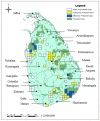Towards a More Efficient In and Ex Situ Conservation of Sri Lankan Wild Rice Species
- PMID: 37299128
- PMCID: PMC10255471
- DOI: 10.3390/plants12112149
Towards a More Efficient In and Ex Situ Conservation of Sri Lankan Wild Rice Species
Abstract
Five species of wild Oryza (O. nivara, O. rufipogon, O. eichengeri, O. rhizomatis and O. granulata), including the endemic species O. rhizomatis, have been recorded in Sri Lanka. These species are facing continuous decline in their populations due to natural and anthropogenic processes, with habitat loss being the main threat. This study aimed to provide information on the distribution, the current status of ex situ and in situ conservation, and to identify high-priority species and sites of wild rice in Sri Lanka, in order to improve the effectiveness of conservation efforts. Occurrence records of Sri Lankan wild rice species were collected from literature, gene banks, and field surveys. The distribution of these species was mapped, and areas with high species richness were identified. A gap analysis was conducted to determine the high-priority areas and species for ex situ and in situ conservation. It was found that about 23% of the wild rice populations in Sri Lanka were within protected areas, and by expanding these protected areas by 1 km, an additional 22% of the populations located on the border of these areas could be effectively conserved. Our analysis also revealed that 62% of Sri Lankan wild rice populations were not represented in gene banks. The species-rich areas were found to be in only two districts (Polonnaruwa and Monaragala), and less than 50% of these areas were within protected areas. Based on these findings, O. rhizomatis, O. eichengeri, and O. rufipogon were identified as high-priority species for in situ conservation. Ex situ collections were also deemed necessary for O. granulata and O. rhizomatis to ensure diversity representation in gene banks.
Keywords: conservation; dormancy; germination; seed; wild rice.
Conflict of interest statement
The authors declare no conflict of interest.
Figures




Similar articles
-
Population genetics and evolutionary history of the wild rice species Oryza rufipogon and O. nivara in Sri Lanka.Ecol Evol. 2018 Nov 11;8(23):12056-12065. doi: 10.1002/ece3.4665. eCollection 2018 Dec. Ecol Evol. 2018. PMID: 30598799 Free PMC article.
-
Phenological and morphological variations of Oryza rufipogon and O. nivara in Sri Lanka and their evolutionary implications.Sci Rep. 2024 Dec 28;14(1):31126. doi: 10.1038/s41598-024-82383-x. Sci Rep. 2024. PMID: 39730894 Free PMC article.
-
Native trees of Mexico: diversity, distribution, uses and conservation.PeerJ. 2020 Sep 18;8:e9898. doi: 10.7717/peerj.9898. eCollection 2020. PeerJ. 2020. PMID: 32999763 Free PMC article.
-
Meta-analysis of genetic representativeness of plant populations under ex situ conservation in contrast to wild source populations.Conserv Biol. 2020 Aug 24. doi: 10.1111/cobi.13617. Online ahead of print. Conserv Biol. 2020. PMID: 32840007 Review.
-
A review of previous studies on the Sri Lankan echinoid fauna, with an updated species list.Zootaxa. 2017 Feb 9;4231(2):zootaxa.4231.2.1. doi: 10.11646/zootaxa.4231.2.1. Zootaxa. 2017. PMID: 28187535 Review.
References
-
- Maxted N., Ford-Lloyd B.V., Kell S.P. Crop wild relatives: Establishing the context. Crop Wild Relat. Conserv. Use. 2008;28:3–30.
-
- Liyanage A.S.U. Situ Conservation of Crop Wild Relatives through the Enhanced Information Management and Field Application Project. Plant Genetic Resources Centre; Peradeniya, Sri Lanka: 2010. Eco-Geographic Survey of Crop Wild Relatives.
-
- Gunawardene N.R. A brief overview of the Western Ghats–Sri Lanka biodiversity hotspot. Curr. Sci. 2007;93:1567–1572.
-
- Vaughan D.A. In Situ Conservation of Wild Rices in Asia. Rice Genet. Newsl. 1990;7:90.
-
- Oka H.I. Origin of Cultivated Rice. Scientific Societies Press; Tokyo, Japan: 1988.
Grants and funding
LinkOut - more resources
Full Text Sources
Miscellaneous

